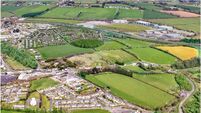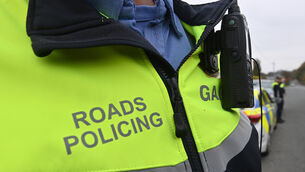Once more, our biggest export is our people
“IT’S in the nature of the people here, emigration has always been seen as part of the way of life.”
So says Marcus O’Cualain as he prepares to leave Connemara for the second time to find work abroad.
And he will not be alone, but the experience is one no longer confined to the rugged far west of the country where the Celtic Tiger left little trace.
Ireland’s biggest export is once again its people, as some 90,000 leave these shores in just 12 months to search for what is not there for them at home: a job, some hope and a future.
It is a thread of despair and departure that has woven its way relentlessly through the tapestry of survival that is the story of Ireland, as the failure of governments — both alien and home grown — have forced the triumph of the individual spirit to reveal itself as ceaseless waves of people leave all they know and strike out across the world on their own.
It was the same for my mother, Bridie, when she left her village of Ballinakill, on the chain of small islands connected by interlocking stone bridges just off the rugged south Connemara coast where so many in the area are again preparing to say goodbye to home to explore the unknown across the waters.
“It was April 14, 1950, I’ll always remember it, I was 18,” my mum recalls.
“One of the cows had just had a calf and my grandfather carried it into the front room to show me before we left, it was tanned with white spots. We were sad to be leaving our home, but also excited at the prospect of what lay ahead, there was very little in Connemara back then, very little in Ireland.”
As the wild Atlantic waves crashed against the rocks of Galway Bay on a bitter November night, in the local education and training centre in the next parish over from Ballinakill, Marcus spoke about his plans to leave. As he was speaking, a music group of 12 and 13-year-olds practiced songs in the background, songs handed down from previous emigrants. The haunting chorus of Amhrán Mhuinse — expressing the longing by someone forced from their home to be buried back where they belonged — permeated the air.
“You can’t beat the wild beauty of this place, when I lived before in London last time I had to get down to Brighton at least once a month just so I could get the feel of the salt water air back in my nostrils,” he says.
As the Amhrán Mhuinse singers finish their lament, who knows where the winds of economic necessity will carry them when the time comes? They will be leaving school just as the Government’s four-year supposed “recovery” plan reaches its end game.
But that plan is already revealed as a testament to failure, its myopic vision of success built on growth rates clearly shown to be grossly inadequate, and ones which could never be achieved anyway with the amount of deflationary triggers in-built within the IMF-dictated blueprint.
This Government, like the de Valera one before is also sacrificing its young, making the dole bill numbers by 2014 “manageable” only by writing-off 100,000 people as emigrants forced to leave the country to experience the dignity of labour. But once again this Government’s figures are wide of the mark as 90,000 are expected to leave in the next year alone. This scale takes us back to the haemorrhage of youth of the 1950s when 500,000 people were exported as economic refugees between 1951-1961.
For my mum, and the others lost in such statistics, the journey was also one of adventure mixed in with the trepidation.
“It was so exciting to get to Euston Station in London for the first time. It was all so new and unexpected. Then you went home to Ireland and when you came back the second time to Euston it just looked so grey and dirty and you knew you were back to work, and that work would be hard — and it would be a long way from home.
“But families had always experienced this, my mother, Delia Cloherty, left for America in 1921 and used to tell us of passing through Dublin on her way to catch the liner in Liverpool — the smoke from the fighting was rising above bombed-out buildings on Dublin’s streets in the War of Independence as she passed by on the train. We knew as children we’d probably have to leave as well when we were older, it’s just so sad that nothing has changed all this time on — after all that struggle and sacrifice.”
Delia, my grandmother, settled in Pennsylvania and Cape Cod and became a noted songwriter with more than 300 compositions to her name before returning to Connemara after marrying her husband, Mark McDonagh, in Pittsburgh after he had fled Connemara due to fighting on the losing side in the Civil War.
The most famous of her songs is The Town Of Cararroe which tells the story of an emigrant’s longing to return from exile in Philadelphia, before its final verse switches into a anti-British occupation tone.
Delia’s generation had good reason to blame the “alien government” cited in the 1916 Proclamation of Independence for the nation’s woes and poverty of hope.
But it was more complex in the frugal 1950s — a quarter century of Free Statehood had finally given way to a Republic, but the deliberate economic stagnation of the de Valera years meant there was little to celebrate at home. And after the fits and starts of expansion the 1970s and the implosion of the bubble boom in 2008, today’s economic meltdown bears all the hall-marks of a home-made disaster.
Brendan Reaney, 27, manager of Hanley’s pub which looks out starkly towards the Aran Islands with little after that until Boston, has seen 10 friends drift abroad for work in the past two years.
“Everybody hoped these days had gone. Then it all seemed to just happen again overnight. They looked for work, kept looking, then left. You can catch up with them on Facebook every night which is good, but it’s not the same. Some are having to come back now because work in England is drying up, but there’s little here apart from the dole, and that’s being cut,” he said.
Sean Coistealbha, 53, chief executive of the Muintearas training centre where the teenagers are learning the songs of emigrants past muses that the generations are again dancing to the music of time.
“There’s a word for resilience in Irish — teacht aniar — it means coming from the West — resilience, the resilience of the people here. We all have that resilience. I left in 1980, but came back in the mid-1980s — it was much more depressed then than it is now, we have the social infrastructure which is a support to people,” he says.
A photo on the centre’s wall from 1986 shows a group of six teenagers who called their singing group Emigration because they were the children of locals who had gone and then came back in the area’s ceaseless ebb and flow of optimistic returns and hard-headed departures. Four of the six remained in the area, but the generation that followed them once again battles against the economic odds to do likewise.
Aisling Bairead, 24, of Leitirmóir, found a job in the local sports centre two years after completing her business and communications degree.
“People go, but they always want to come back, there isn’t much work and so many of my friends have gone to Australia and America, part of it is the buzz of travelling. It isn’t all misery,” she says.
While the huge distances today’s migrants travel are shortened by Ryanair and advances like Skype, it was not always so.
My mum’s journey from London back to Connemara would always be an epic one: “It was six hours on the train to Holyhead, then three and a half hours on the boat, and the train to Galway would be at least five hours after that. Then you’d get a bus, but that would take two hours to get to Casla, which was only part of the way, so someone would come and get you in a pony and trap, which would take about another hour and a half. It would be something like 18 hours in all — you could get to Australia in that time these days.”
“We went back every summer and loved doing the work on the farm that we had previously thought of as such hard work. We knew that the work in London was tougher, but we wanted to send money back to help out back home — like the Polish do in Ireland now I suppose — and like the Irish are once again doing from England and all over the world. There was no work in Ireland then and no benefits, there was a scheme for people from the Gaeltacht, but it was limited, you could go to Dublin to train as a teacher or join the nuns. I didn’t want to be a nun, and although I passed the teaching exams, there had been a mix-up and I was a month or two too old and so was told it didn’t count,” she says.
So, with her mother and older sister Mary already in post-war, Blitz-bombed London, my mum — whose nickname within the family was “Baby” — and her cousin Mary McDonagh, also 18, set off on their trek that cold April day in 1950.
“It cost about £3 to travel to and from England which was about a week’s wages at the time. It felt like the whole, village was in London after a while — you were with your people. You’d go to the dances and see everyone from back home. The Laurel Tree in Camden Town was always the place for good music and the craic. West Indians had started to arrive in London by then, like us — looking for work they couldn’t get at home — and we got on really well. They had to put up with more prejudice than us, poor things. I never really experienced any racism, thank God, the Irish would tend to share houses with each other and keep a very close community together,” she said.
Emigration had been a part of the Irish story from the early 19th century onwards, but only reached crisis point during the Famine and its aftermath, and again in the 1950s when one-in-three people under the age of 30 in 1946 had left Ireland by 1971 — my mum included.
Are we now at the third crisis point? Have we come full circle?
“I’ve lived in England for 60 years now, but Ballinakill will always be my home,” she says.













